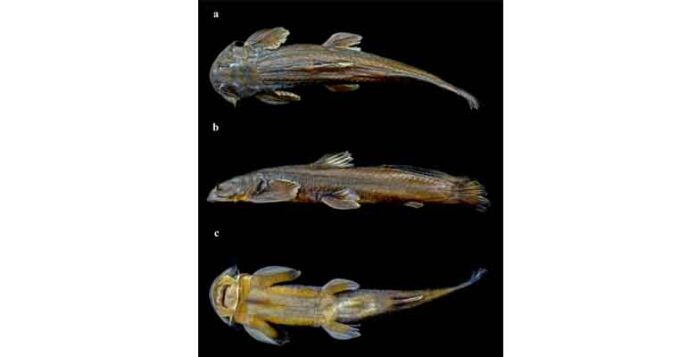In a major discovery for biodiversity, a new species of catfish named Exostoma Sentiyonoae has been identified in the rivers of Nagaland, India. This exciting find contributes to the understanding of India’s freshwater biodiversity and highlights the rich, unexplored ecosystems in the Northeast region. The discovery not only emphasizes Nagaland’s ecological importance but also provides new insights into the diversity of catfish species within the subcontinent.
Exostoma Sentiyonoae: A New Addition to India’s Freshwater Biodiversity
The discovery of the Exostoma Sentiyonoae adds to the rich array of freshwater species found in the rivers of Nagaland. Named after Dr. Sentiyono, a prominent researcher contributing to ichthyology, this species belongs to the Sisoridae family, a group of catfish known for their elongated bodies and specialized features adapted to fast-flowing water environments. The species was identified in streams and tributaries of Nagaland, where the water current and habitat conditions favor its survival.
This discovery was the result of an extensive survey and collaborative research effort by scientists from India’s Zoological Survey of India (ZSI), local academic institutions, and biodiversity experts. The findings were recently published in a renowned scientific journal, marking a proud moment for both the scientific community and the region.
The Importance of the Discovery
- Contribution to Science: The identification of Exostoma Sentiyonoae is a milestone in ichthyology, particularly in the study of Sisoridae catfish. The discovery of new species helps scientists understand the evolutionary relationships between different fish families, their adaptations to unique environments, and their roles within ecosystems.
- Biodiversity Hotspot: Nagaland, a part of India’s Northeast biodiversity hotspot, is known for its rich and diverse ecosystems. The discovery highlights the importance of conserving these habitats, which are home to numerous endemic and undiscovered species. The unexplored rivers and streams of the Northeast region continue to be promising areas for future research.
- Significance for Conservation: Freshwater ecosystems globally are under threat due to habitat destruction, pollution, and climate change. The discovery of a new species underscores the need to protect these habitats. Exostoma Sentiyonoae adds to the list of species that conservationists aim to protect, ensuring the long-term sustainability of freshwater biodiversity in the region.
- Ecological Insights: The new species also provides valuable insights into the ecological balance within Nagaland’s river systems. Catfish play an essential role as scavengers and predators, contributing to the maintenance of healthy ecosystems. Understanding the behavior, habitat preferences, and ecological roles of new species like Exostoma Sentiyonoae is critical for the broader understanding of aquatic ecosystems in the region.
Unique Features of Exostoma Sentiyonoae
The newly discovered Exostoma Sentiyonoae exhibits several distinguishing features that set it apart from other catfish species:
- Morphological Characteristics: This species has an elongated body with specialized adaptations for living in fast-moving, rocky streams. Its flattened head and streamlined body help it navigate through the turbulent water currents typical of mountain rivers in Nagaland.
- Coloration and Size: The species is notable for its distinct color pattern, with a dark brown body and lighter patches along its sides. It is a relatively small catfish, measuring between 8-10 cm, which is typical of species found in rapid river systems.
- Adaptation to Fast-Flowing Waters: Like other members of the Sisoridae family, Exostoma Sentiyonoae has developed adhesive abilities on its ventral surface, allowing it to cling to rocks and substrates in fast-moving waters, which prevents it from being swept away by strong currents.
Impact on Nagaland’s Ecology and Future Research
The discovery of Exostoma Sentiyonoae brings attention to the unique ecological characteristics of Nagaland’s freshwater systems. Rivers and streams in this region are home to several endemic species that have adapted to the area’s fast-flowing waters, rocky terrains, and diverse aquatic vegetation. This discovery opens the door for future research into the ecology of these river systems, which remain relatively understudied.
Moreover, the discovery prompts the need for increased conservation efforts. The growing human population, increased agriculture, and infrastructure development pose threats to these fragile ecosystems. Habitat fragmentation, pollution from agricultural runoff, and climate-induced changes are potential risks that could impact the survival of newly discovered species like Exostoma Sentiyonoae.
Conservationists and researchers are calling for stricter protections for Nagaland’s river systems. These include measures to safeguard water quality, prevent overfishing, and preserve the natural habitats that support not only Exostoma Sentiyonoae but also other aquatic species.
Involving local communities is crucial for the success of conservation efforts. Indigenous communities in Nagaland have a deep connection with the natural environment, and their traditional knowledge can provide valuable insights into sustainable resource management. Several community-led initiatives in Nagaland have shown success in wildlife conservation, and a similar model could be applied to protecting freshwater ecosystems and species like Exostoma Sentiyonoae.
The discovery of Exostoma Sentiyonoae serves as a reminder of the vast and largely untapped biodiversity that India’s Northeast region offers. It highlights the need for continued exploration, documentation, and protection of these ecosystems. As scientists continue to delve into the hidden treasures of Nagaland’s rivers, the discovery of new species will provide critical data to understand and preserve the region’s unique ecological heritage.




